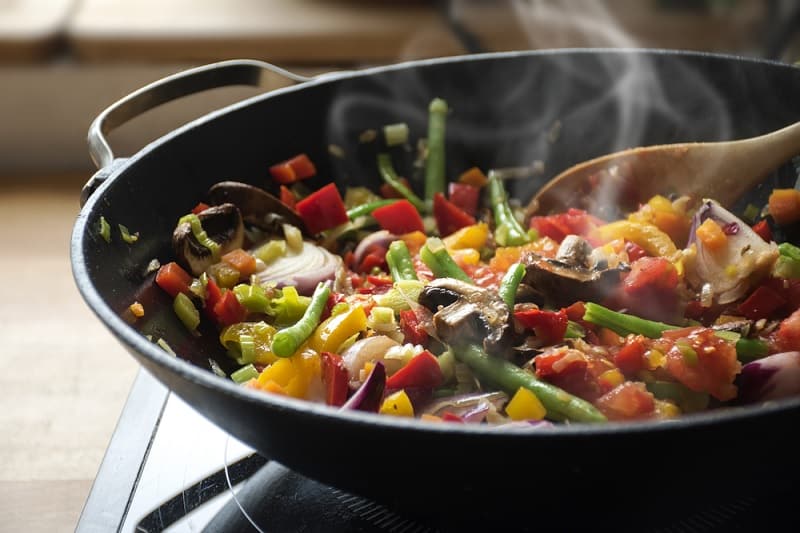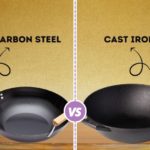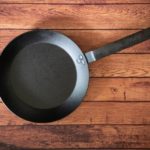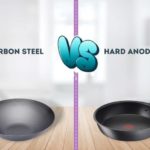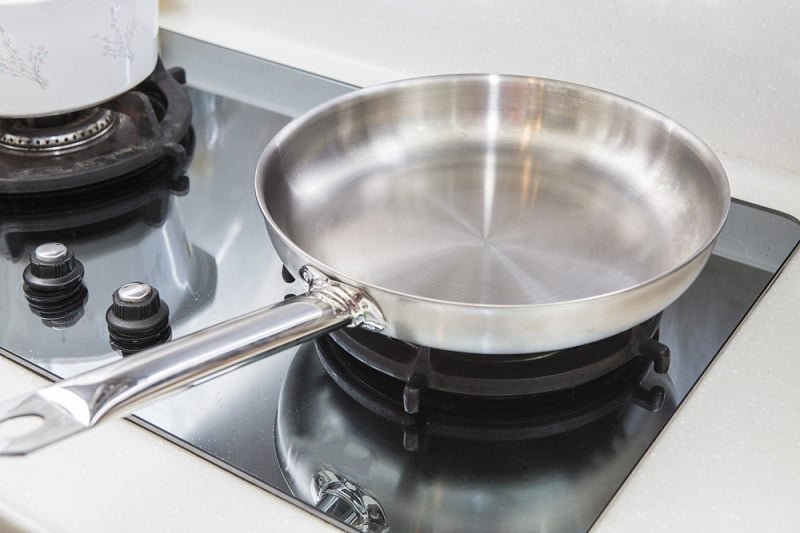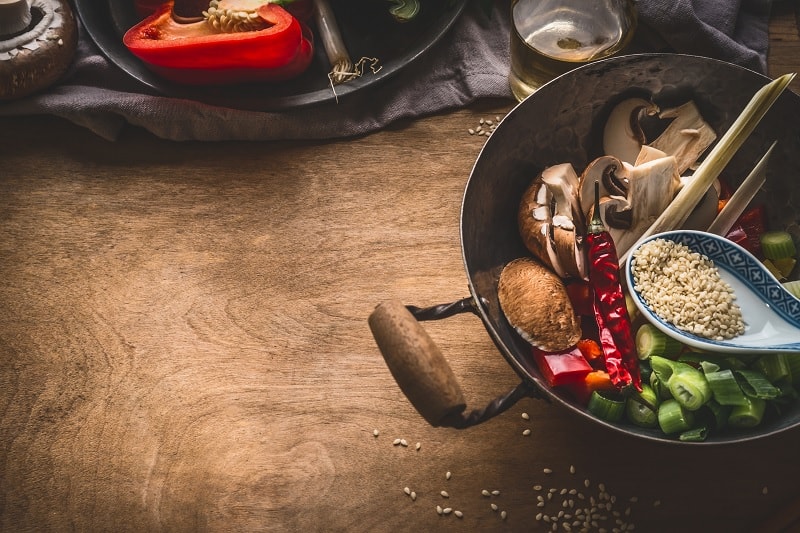We love a wok. If you enjoy cooking Chinese food and you haven’t yet got a wok, you are really missing out.
Having a wok makes stir-fries so easy and quick. However, as we’ll get to in a bit, a wok has so many more uses than just stir-fries.
We’ve got a great list of woks available in the UK right now just below.
The Best Carbon Steel Woks in the UK
1. Craft Wok Traditional Wok
Diameter: 36 cm (14 inches)
We love this wok. It is a traditionally made wok that is completely carbon steel.
You may notice that this wok has a bit of hammered texture to it. That is because it is handmade. It is shaped by working the carbon steel with a hammer and then the wooden handle is rivetted in by hand too.
This item is made from 1.8mm carbon steel, so it is heavy, but you can feel the quality the moment you pick this wok up.
This wok has a rounded bottom. This means that it won’t work on most induction hobs (unless you have a wok ring). It also doesn’t do too well on electric hobs, but it is perfect for gas hobs.
You do need to season this wok before you use it, but that is really simple. This product is very well made, and should last you for many years.
2. Souped Up Recipes Carbon Steel Wok
Diameter: 31.75 cm (12.5 inches)
The carbon steel wok from Souped Up Recipes comes to us courtesy of its namesake Youtuber.
This flat-bottomed wok is suitable for use on both electric and induction stoves, gas range cookers and a range of other heat sources. The care instructions are simple, making the wok extremely easy to take care of.
The wok has a printed hammered effect texture which is uncoated. The wok will need seasoning before using it for the first time and instructions on how to do this are included.
However, some people have reported that they struggled with the seasoning process.
Overall, the wok has a good weight to it and feels good quality. It is easy to clean, and when seasoned correctly, it is completely non-stick too.
3. SQ Professional Ultimate Carbon Steel Non-Stick Wok
Diameter: 34 cm (13.5 inches)
The SQ Professional is an affordable carbon steel non-stick wok that is suitable for use on the majority of hobs, including induction.
The flat bottom makes the wok easy to use, and the long handle with loop makes it easy to store.
The wok has a robust construction that enables heat to transfer quickly throughout its body, and the sturdy non-stick coating means you’ll need to add little to no oil for most dishes.
This wok is even pre-seasoned, saving you the hassle of needing to do it yourself.
Users find that the wok looks great, is sturdy and produces good results. However, like many products of this nature, it is worth remembering that you should not use metal cooking utensils or scouring pads to clean the wok as it could damage the surface.
4. Dexam Professional Carbon Steel Wok
Diameter: 34 cm (13.5 inches)
This professional wok is made from 1.8 mm carbon steel. It is also made with a flat bottom. So, unlike the other traditional, yet professional, woks above, it does work on modern cookers, including induction.
You’ll notice that this wok doesn’t have a hammered texture. This is because this wok is made for the professional market. So, machines have been used to ensure every wok performs perfectly.
You’re likely to see this wok in most professional Asian kitchens in the UK. It is a quality bit of cookware that will perform in a pro kitchen for many years.
So, this wok, as long as you look after it, will likely be around for you to pass down to your kids. For that price, that is amazing!
5. School of Wok Carbon Steel Wok
Diameter: 36 cm (14 inches)
Take a close at this wok, and you’ll see loads of little lines circling around the inside. This is likely because this carbon steel wok was handspun meaning that there is no stress in the fabric of the material and that it is a quality bit of kit.
The School of Wok, by the way, is a company based in Covent Garden that makes some of the best Asian cookware in the UK.
So, this carbon steel wok had to make our list. The quality of this wok is evident from the moment you pick it up. Plus, School of Wok provides simple seasoning instructions and care tips in the box. If this wok doesn’t last you a decade or more, none will!
Why Choose a Carbon Steel Wok?
Carbon steel cookware is very popular with pros, but there isn’t much carbon steel in home kitchens. Why is this? Why do the pros love carbon steel and yet it never rarely gets mentioned in the home cooking world?
Well, pro chefs love carbon steel because it performs certain tasks better than any other type of cookware.
One of these tasks happens to be frying at high heat quickly. So, carbon steel is pretty much the perfect material for a wok as all of the cooking done in a wok is fast and high.
Another great thing about carbon steel is its construction. The material itself is made from 99% iron and 1% carbon.
Of course, if it were 100% iron, it would be a cast-iron creation. Cast iron, as anyone with a cast iron skillet, will know, is pretty brittle. You only have to look at cast iron in the wrong way, and it can break.
However, the addition of that 1% of carbon makes the material much more durable. It can also be worked a lot better than iron, so carbon steel cookware can be thinner and therefore lighter. It can also be seasoned just like cast iron too.
So, why choose a carbon steel wok? Well, carbon steel is a fantastic choice for a wok. There is no non-stick coating that will break down over time. It is pretty lightweight and heats up very quickly and retains this heat too. So, it’s almost like carbon steel was created for woks!
How to Choose a Carbon Steel Wok
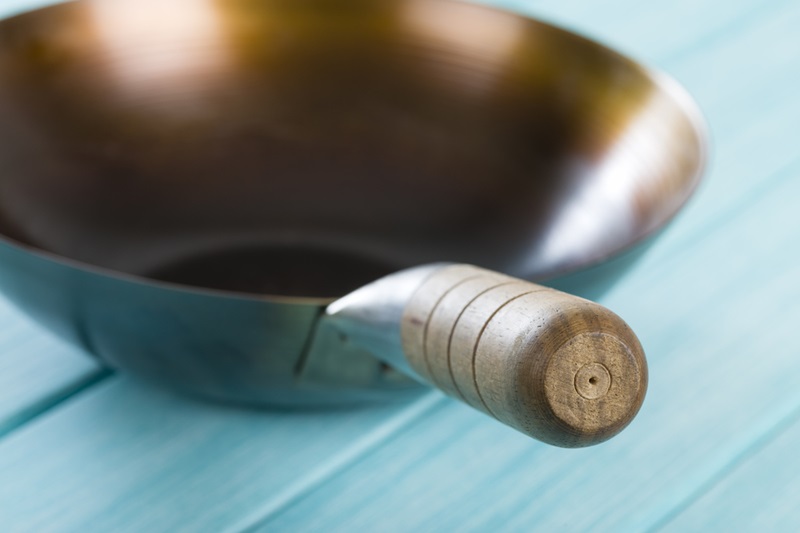
Carbon steel woks tend to be the most popular choice, and with good reason. They tend to be preferred not only by Chinese restaurants, but by many households too.
Handles
The first consideration when buying any new wok should be the handles. Traditional large woks have two metal handles, but many woks that you would find today are actually “pow woks” with single handles.
How you plan on using the wok will determine if you are better off with a single handled wok or need a traditional, two handled version.
Size
Woks come in a range of shapes and sizes. Restaurants tend to use enormous woks that are far too big for the average home, but even domestic woks can be found in sizes ranging between 10 and 20 inches.
A 13- or 14-inch wok will be perfect for most households cooking on the typical hob.
If you use your wok outside over an open fire with a wok stand, you can of course look for a larger one if you’d like!
Shape
Traditional woks have a round bottom, which is fine if you are using it with a wok stand, but does not work so well on modern hobs, especially induction ones.
With that in mind, modern woks are often available with a flat bottom. This means the wok will have an adequate magnetic surface area for the induction hob to work, and it means it can rest flat without you holding it up all the time too!
Lids
Most woks are supplied without lids, and some people feel that this means you don’t need one.
However, this couldn’t be further from the truth. Many traditional recipes are much easier to cook if you have a lid for your wok, especially if the recipe calls for ingredients to be simmered.
Is a Carbon Steel Wok Worth It?
Carbon steel woks have always been the instrument of choice in Chinese cuisine, and this has been the case throughout much of history.
Carbon steel was first made in China around the 6th century BC, and since then has been used to make tools, weapons and a range of other instruments around the world.
Today, carbon fibre production has been improved so much so that you won’t find many impurities in a carbon steel wok.
The centuries of knowledge that are behind the humble carbon steel wok bring a wealth of advantages for the average user.
From being easy to handle to being free from toxins, there are a variety of reasons why a carbon steel wok is a worthwhile investment.
Lightweight
Carbon steel is incredibly lightweight, and as a result, carbon steel woks can easily be some of the cheapest available on the market.
The lightness makes carbon steel woks much more comfortable to use as you aren’t moving something heavy each time you move the food around to stop it burning.
Environmentally friendly
Carbon steel is entirely made from carbon and iron. When cooking using this combination, no harmful chemicals are released into the environment, or your food.
Natural non-stick
Carbon steel woks build up a non-stick coating gradually over time. This is known as seasoning. You want to use an oil that is non-toxic and has a high smoke point, such as canola or peanut oil for best results.
Conducts heat quickly
Carbon steel responds very quickly and well to changes in temperature. This means that food will not take long to cook because the wok heats up so fast, but it also reduces the risk of burning your food if you need to drop the temperature suddenly.
Which Is Better: A Stainless Steel or Carbon Steel Wok?
Both carbon steel and stainless steel are prevalent in the modern kitchen, and when it comes to woks, both bring their own benefits and issues.
Although both alloys are made with a combination of carbon and iron, they couldn’t be more different thanks to the difference in carbon content.
Carbon steel has a much higher carbon content, which makes it strong and malleable.
Stainless steel, however, has a high chromium content and contains very little carbon. It is the chromium that gives stainless steel its “stainless” qualities.
Purchase cost
Carbon steel woks are usually much more affordable than stainless steel ones. This is simply because a lot of the materials added to stainless steel, such as aluminium, nickel and chromium all add to the purchase price, whereas carbon steel doesn’t have any added materials.
Heat distribution and conduction
When it comes to conducting heat, carbon steel is much more effective than stainless steel and can retain heat for a couple minutes after removing the pan from the heat.
Non-stick properties
Unlike many other types of wok, carbon steel woks develop their own non-stick coating over time. This is from the layers of oil that build up when the wok is seasoned. Not only does this make the wok non-stick and rust-resistant.
By comparison, stainless steel woks are only non-stick if an added coating is used by the manufacturer.
Maintenance
Unlike carbon steel, stainless steel does not require a great deal of maintenance. It does not need seasoning, and the surface is less prone to damage when compared to an equivalent carbon steel wok.
Cleaning
Stainless steel woks are much easier to clean than carbon steel. Carbon steel has to be carefully wiped out using gentle cleaning utensils, whereas stainless steel can just be thrown in the dishwasher if you really want to.
Differences Between Carbon Steel vs. Non-Stick Cookware
1. Base material
Carbon steel pans are made from 99% iron and 1% carbon. This differs from regular cast iron pans which contain around 3% carbon.
Although it doesn’t sound like much, the marginal amount of extra iron in the base metal means carbon steel pans are incredibly lightweight. They’re also extremely durable and designed to last a lifetime.
On the other hand, non-stick pans refer to any type of cookware that has a non-stick coating applied over the top of the metal.
Therefore, these pans can be made from almost anything, with aluminium or stainless steel the two most popular options. The characteristics of the pan can vary dramatically depending on which base metal you choose.
2. Non-stick coating
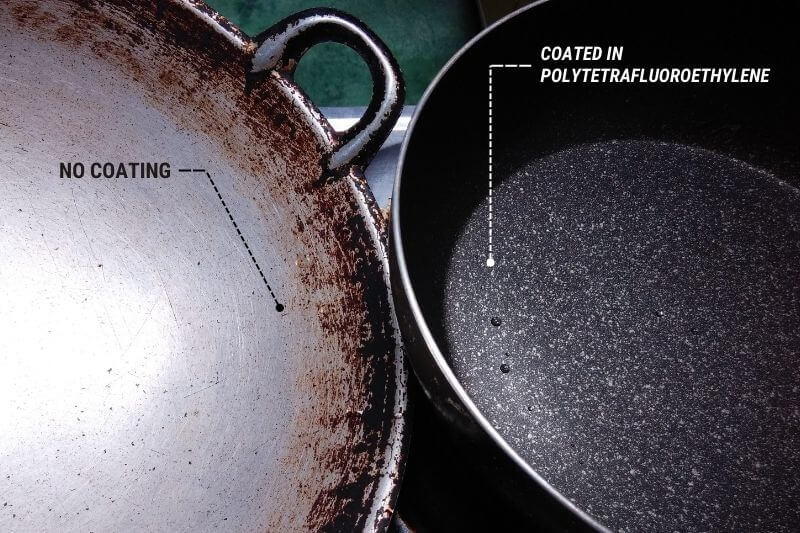
The cooking surface of non-stick cookware is coated in another material to give it non-stick qualities. Most non-stick pans are coated in polytetrafluoroethylene.
This chemical is also known as Teflon and is the substance used to produce the non-stick property of all Teflon-branded cookware.
On the other hand, some non-stick pans are coated in ceramic which gives a smooth non-stick cooking experience.
Comparatively, carbon steel pans do not have any type of coating. But despite this, carbon steel cookware is still non-stick.
The exact combination of carbon and iron means these pans have natural non-stick properties following a “seasoning” process:
- Wash your new carbon steel pan to remove the protective coating
- Dry the pan and put it over a burner to heat the metal and remove any remaining moisture
- Rub and buff vegetable oil into all surfaces of the pan using a clean tea towel
- Heat the oiled pan on a burner or in the oven until the surface turns a brown colour
- Beware that the oil will smoke during this process so have fans on and windows open!
- Remove from the heat and repeat until the entire pan is a dark shade of brown
After you have seasoned your carbon steel pan, you should be able to use it without the contents sticking. The more you cook in it, the better the seasoning becomes.
3. Durability
The base material of both carbon steel pans and non-stick pans is very durable. They are both made from strong metals designed to withstand high temperatures so you can cook using them repeatedly.
As carbon steel does not have a coating, its non-stick properties also last a lifetime.
However, synthetic non-stick coatings are far less durable. Through washing the pan, scratching the cooking surface, and cooking on high heat, these pans gradually lose their non-stick qualities over around five years.
This can be prolonged by only handwashing your cookware and using silicone utensils to prevent scratching. But these pans are not as durable and will need to be replaced.
4. Metal reactivity

Whenever you cook there is a chance for metal ions to leach into your food from the base material.
This generally happens when cooking acidic food such as tomato-based dishes or foods that contain wine and lemon in their recipes.
Carbon steel is a highly reactive metal, meaning that iron will leach into certain foods as you cook them.
Thankfully, this does not have any negative health consequences and many people are deficient in iron, thus it could bring some health benefits. However, it can end up adding a metallic taste to your food and ruining your meals.
On the other hand, non-stick cookware is coated in a synthetic layer, meaning that no ions from the metal beneath will leach into your food.
Therefore, you can cook acidic dishes in these pans without worrying. With that said, non-stick coatings do wear away over time.
When this happens, the base metal can then leach into your food. This may or may not be detrimental to human health depending on the material the pan is made from.
5. Aesthetic design
If you’re concerned about the aesthetic appeal of your cookware, you’ll probably want to purchase non-stick pans.
Many non-stick pots and pans will have a generic design with a black surface inside and out. However, ceramic cookware comes in a variety of colours and patterns, so you’re sure to find one that matches your kitchen décor.
On the other hand, carbon steel pans aren’t the easiest on the eye. Newly-seasoned pans typically have an uneven colouration and blotchy appearance, making them look older than they are.
Even well-seasoned pans are bland and always have a characteristic unsightly brown colour.
6. Price & availability

Price and availability are another big difference between carbon steel vs non-stick cookware. Carbon steel cookware is generally pretty affordable and a great option for anyone on a tight budget.
Non-stick pans are more expensive, but this does depend on the brand, base metal, and coating of the pan in question. If you want to shop for non-stick pans on a budget, you can.
With that said, the availability of both types of pans might also affect your shopping decisions. Non-stick pans are a home-kitchen favourite and are found in almost every cookware shop.
However, carbon steel pans are only just finding their way into the home and you might have fewer options or limited availability are your local department store.
What Can You Cook in a Wok (Apart From Stir-Fries)?
If you could only use a wok for stir-fries, would it be worth it? After all, you can stir fry in a frying pan (sort of). Well, woks are great for other types of high-heat cooking, for example:
- Warming tortilla wraps
- Making popcorn
- Deep frying – woks are perfect for deep frying!
- Steaming – grab some bamboo steamers and you can easily use a wok to steam veg, dumplings and more.
Woks are actually pretty versatile pieces of cookware. After all, the thing that makes a wok great is that it heats up quickly and retains that heat for frying.
They are also nice and big, so you can fry loads of stuff at once. This means that you can use a wok for loads of different tasks and not just for stir-fries.
We aren’t saying you’ll use your new wok every day, but mine certainly get used a lot for loads of different tasks.
Conclusion
So, there are the best carbon steel woks in the UK right now. We hope you found the best wok for your kitchen above.
We love the Craft Wok Traditional Wok. It is beautifully made and a joy to use.
If you’re looking for more cookware recommendations, check out our other articles. We have all of the cookware you need right here to cook even the most complex dishes in your kitchen.

Scott is a writer and a passionate home chef. His passion for cooking began when he was 10 years old. Scott has been writing professionally for over five years now and loves to combine his passion for cooking with his day job.

